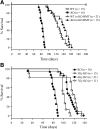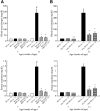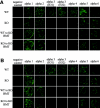Irradiation prolongs survival of Alport mice
- PMID: 18480315
- PMCID: PMC2518432
- DOI: 10.1681/ASN.2007070829
Irradiation prolongs survival of Alport mice
Abstract
Alport syndrome is a hereditary nephropathy that results in irreversible, progressive renal failure. Recent reports suggested that bone marrow transplantation (BMT) has a beneficial, short-term effect on renal injury in Alport (Col4a3(-/-)) mice, but its long-term effects, especially with regard to survival, are unknown. In this study, Alport mice received a transplant of either wild-type or Col4a3(-/-) bone marrow cells. Surprising, laboratory evaluations and renal histology demonstrated similar findings in both transplanted groups. Transplanted cells accounted for >10% of glomerular cells at 8 wk, but type IV collagen alpha3 chains were not detected in glomerular basement membranes of either group by immunofluorescence or Western blot analysis, although Col4a3 mRNA in the kidney could be amplified by reverse transcription-PCR in knockout mice that received a transplant of wild-type bone marrow. Both transplanted groups, however, survived approximately 1.5 times longer than untreated knockout mice (log rank P < 0.05). These data suggested that irradiation, which preceded BMT, may have conferred a survival benefit; therefore, the survival time of knockout mice was assessed after sublethal irradiation (3, 6, and 7 Gy) without subsequent BMT. A strong positive correlation between irradiation dosage and survival time was identified (P < 0.0001). In conclusion, the improved survival observed in Alport mice that received a transplant of wild-type bone marrow might be primarily attributed to as-yet-unidentified effects of irradiation.
Figures







Comment in
-
Stem cell-based therapy for glomerular diseases: an evolving concept.J Am Soc Nephrol. 2008 Sep;19(9):1621-3. doi: 10.1681/ASN.2008070735. Epub 2008 Aug 13. J Am Soc Nephrol. 2008. PMID: 18701605 No abstract available.
Similar articles
-
Bone marrow-derived cells contribute to podocyte regeneration and amelioration of renal disease in a mouse model of Alport syndrome.Stem Cells. 2006 Nov;24(11):2448-55. doi: 10.1634/stemcells.2006-0201. Epub 2006 Jul 27. Stem Cells. 2006. PMID: 16873763
-
Stem cell therapies benefit Alport syndrome.J Am Soc Nephrol. 2009 Nov;20(11):2359-70. doi: 10.1681/ASN.2009010123. Epub 2009 Oct 15. J Am Soc Nephrol. 2009. PMID: 19833902 Free PMC article.
-
Albumin contributes to kidney disease progression in Alport syndrome.Am J Physiol Renal Physiol. 2016 Jul 1;311(1):F120-30. doi: 10.1152/ajprenal.00456.2015. Epub 2016 May 4. Am J Physiol Renal Physiol. 2016. PMID: 27147675 Free PMC article.
-
Collagen IV diseases: A focus on the glomerular basement membrane in Alport syndrome.Matrix Biol. 2017 Jan;57-58:45-54. doi: 10.1016/j.matbio.2016.08.005. Epub 2016 Aug 27. Matrix Biol. 2017. PMID: 27576055 Free PMC article. Review.
-
Alport syndrome and thin glomerular basement membrane nephropathy: a practical approach to diagnosis.Arch Pathol Lab Med. 2009 Feb;133(2):224-32. doi: 10.5858/133.2.224. Arch Pathol Lab Med. 2009. PMID: 19195966 Review.
Cited by
-
Searching for a treatment for Alport syndrome using mouse models.World J Nephrol. 2014 Nov 6;3(4):230-6. doi: 10.5527/wjn.v3.i4.230. World J Nephrol. 2014. PMID: 25374816 Free PMC article. Review.
-
Mesenchymal stem cells as a therapeutic approach to glomerular diseases: benefits and risks.Kidney Int Suppl (2011). 2011 Sep;1(3):68-73. doi: 10.1038/kisup.2011.16. Kidney Int Suppl (2011). 2011. PMID: 25018904 Free PMC article. Review.
-
Cellular origins of type IV collagen networks in developing glomeruli.J Am Soc Nephrol. 2009 Jul;20(7):1471-9. doi: 10.1681/ASN.2008101086. Epub 2009 May 7. J Am Soc Nephrol. 2009. PMID: 19423686 Free PMC article.
-
COL4A6 is dispensable for autosomal recessive Alport syndrome.Sci Rep. 2016 Jul 5;6:29450. doi: 10.1038/srep29450. Sci Rep. 2016. PMID: 27377778 Free PMC article.
-
Podocyte-specific Crb2 knockout mice develop focal segmental glomerulosclerosis.Sci Rep. 2021 Oct 15;11(1):20556. doi: 10.1038/s41598-021-00159-z. Sci Rep. 2021. PMID: 34654837 Free PMC article.
References
-
- Barker DF, Hostikka SL, Zhou J, Chow LT, Oliphant AR, Gerken SC, Gregory MC, Skolnick MH, Atkin CL, Tryggvason K: Identification of mutations in the COL4A5 collagen gene in Alport syndrome. Science 248: 1224–1227, 1990 - PubMed
-
- Mochizuki T, Lemmink HH, Mariyama M, Antignac C, Gubler MC, Pirson Y, Verellen-Dumoulin C, Chan D, Schroder CH, Smeets HJ, Reeders ST: Identification of mutations in the alpha 3(IV) and alpha 4(IV) collagen genes in autosomal recessive Alport syndrome. Nat Genet 8: 77–81, 1994 - PubMed
-
- Gross O, Beirowski B, Koepke ML, Kuck J, Reiner M, Addicks K, Smyth N, Schulze-Lohoff E, Weber M: Preemptive ramipril therapy delays renal failure and reduces renal fibrosis in COL4A3-knockout mice with Alport syndrome. Kidney Int 63: 438–446, 2003 - PubMed
-
- Gross O, Schulze-Lohoff E, Koepke ML, Beirowski B, Addicks K, Bloch W, Smyth N, Weber M: Antifibrotic, nephroprotective potential of ACE inhibitor vs AT1 antagonist in a murine model of renal fibrosis. Nephrol Dial Transplant 19: 1716–1723, 2004 - PubMed
Publication types
MeSH terms
Substances
LinkOut - more resources
Full Text Sources
Medical

